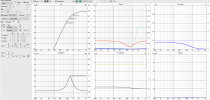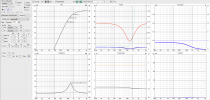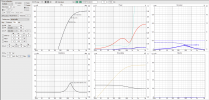How Magico tested their M9 (weighs 1000 lb) with their NFS.
I seriously doubt John Atkinson gets paid enough to do ^^^THAT^^^.
How Magico tested their M9 (weighs 1000 lb) with their NFS.
That would make exact comparisons with our favourite reviewers and others possible?Upgrading to a Klippel NFS would help them do better measurements, but maximum measurement quality may not be their objective.
They give a balanced take between subjective and objective, and a lot of their readers are only sort of interested in measurements in the first place.
More importantly, I think, it would reveal genuine flaws in the designs of huge numbers of their advertisers. How can they discuss the most expensive B & W speaker measuring worse than a $3000 pair of Ascend speakers? Or Wilson or a dozen or more other brands? They would lose advertisers, AND tons of readers. I doubt they would survive such a transition.That would make exact comparisons with our favourite reviewers and others possible?
That migth not always be in stereophiles interest
Even if it would be extremely cool if everyone measured to the same standard.
The arraying does not change the Fs. What helps to make it work is that each individual tweeter doesn't have to play that loud in this midrange area. This hopefully ensures to not damage the drivers and keeping the distortion at this frequency area at some reasonable level. A steep slope higher order filter may also help. Anyway it is hard to say how well behaving the tweeters operate at that low frequency range. I guess the layout is really at the edge toI have what may be an overly naive question about this tweeter array business.
Arraying* a whole bunch of identical drivers doesn't change the Fs of any one of those drivers -- or does it?
If it doesn't, how is it safe to drive an array such that any one of the drivers is asked to respond to frequencies (e.g.) < 2 x Fs?

I have what may be an overly naive question about this tweeter array business.
Arraying* a whole bunch of identical drivers doesn't change the Fs of any one of those drivers -- or does it?
If it doesn't, how is it safe to drive an array such that any one of the drivers is asked to respond to frequencies (e.g.) < 2 x Fs
I guess the layout is really at the edge to
- not kill the amplifier due to low impedance
- not kill the tweeters
- not create to much distortion
- still beeing able to play loud enough
The impedance will be never below a single 4 Ohm tweeter - so no problem for the amplifier. The capacitor further increases the impedance at low frequencies.
- not kill the amplifier due to low impedance
Due to the high number of tweeters, power handling is not a problem at all, even if the -6dB point is between 700-800Hz.
- not kill the tweeters
The array of six tweeters increases the SPL by 6dB (3 serial, 2 groups parallel) at the same voltage while at the same time greatly reducing excursion.
- not create to much distortion
With a capacitor for a crossover frequency between 700-800Hz (-6dB point) max SPL of the six tweeter array will >110dB.
- still beeing able to play loud enough
The tweeters used for the arrays of the "high-end" Tekton speaker have roughly the following key data: fs 600Hz, xmax 0.25mm, power handling 80W with BU2@2600Hz.
Update: Fixed and clarified tweeter impedance.
Don't get me wrong I am not saying the tweeter array is not working at all or not working reasonable well. Infact I believe all 4 mentioned criteriaThe tweeters used for the arrays of the "high-end" Tekton speaker have roughly the following key data: fs 600Hz, xmax 0.25mm, power handling 80W with BU2@2600Hz.
At 85dB SPL such a tweeter (e.g. TW29BN-B, TW29DN-B) remains below 1% HD at 1kHz. Below fs, the frequency response drops off as a second-order high-pass filter, which means that the excursion at low frequencies virtually no longer increases (because SPL is reduced by the filter).
If a capacitor with a relatively large capacitance (>15-18µF) is connected in series with the tweeter, the filter order increases to three at low frequencies. The -6dB point would then be around 700-800Hz and excursion is reduced.
The midrange tweeter arrays use between 6-14 tweeters.
So let's look at the smallest array with six tweeters.
These are connected in 3 serial pairs and then these three pairs are connected in parallel (using 8 Ohm version of the tweeter) or 3 tweeter serial and these two groups parallel (4 Ohm version).
The impedance will be never below a single 4 Ohm tweeter - so no problem for the amplifier. The capacitor further increases the impedance at low frequencies.
Due to the high number of tweeters, power handling is not a problem at all, even if the -6dB point is between 700-800Hz.
The array of six tweeters increases the SPL by 6dB (3 serial, 2 groups parallel) at the same voltage while at the same time greatly reducing excursion.
To achieve the same excursion as a single tweeter at 85dB (which has <1% HD), SPL must be increased to around 101dB.
This means that the array has less than 1% HD at over 100dB SPL around 1kHz.
The capacitor reduces the excursion even further (-6dB point is between 700-800Hz) and thus also distortion. So one could expect low distortion from the tweeter array.
With a capacitor for a crossover frequency between 700-800Hz (-6dB point) max SPL of the six tweeter array will >110dB.
Update: Fixed and clarified tweeter impedance.
Distortion would also be my if at all concern. I found the following SB Acoustics Berylium tweeter reviews freely available:Some more assumptions:
- distorsions at resonance frequencies are lot higher than at double of it
- if not only C but also L comes into xover the peaking impedance will do no good (and at this low frequency only 6 dB will probably not be sufficent)
- not only excursion but frequency-dependant distorsions should come into equation
- ....

Distortion would also be my if at all concern. I found the following SB Acoustics Berylium tweeter reviews freely available:
Satori TW29B | HiFiCompass
hificompass.com

The SB Acoustics Satori TW29BN Beryllium Dome Tweeter
Test Bench of SB Acoustics' new high-end Satori line neodymium 29 mm beryllium dome tweeter, the TW29BN.audioxpress.com
Would never say that a tweeter array is an ingenious concept for the midrange. But it should work down to 800Hz.had been taken into account and therefore the design is as it is. But at the end you pay a rather high price (in terms of tweeter driver costs) to achieve a lower crossover point, which is still pretty high to crossover with 12" woofers.
Something about speakers and volume pricing strikes me as awfully funny in a dad-humor-pun kind of way...Of course, volume pricing will be better, but still adds up!

As a Dad, fully own it too!Something about speakers and volume pricing strikes me as awfully funny in a dad-humor-pun kind of way...

If the 6 speakers playing together are 6 dB louder than 1 tweeter, then if the array is playing at 96 dB, wouldn't each tweeter be playing at roughly 90 dB? Depending on the specific tweeter used in the specific Tekton model, some of those tweeters do have greater than 1% distortion in the 800-900 Hz range I think. From photos and product descriptions Tekton uses Peerless, SB, and Seas tweeters, and unsurprisingly it appears to have changed over time for some models. Yes, due to the crossover the array would be playing several dB lower at 800-900 Hz than the speaker overall, with the amount depending on the real crossover point, something I've noticed Tekton doesn't actually list for many of their speakers (I must have found it earlier in the Stereophile review). Just trying to sort it but it seems it would be possible to get to the point of distortion if music peaks are in the 100~105 range while listening to ~95 dB programming.The array of six tweeters increases the SPL by 6dB (3 serial, 2 groups parallel) at the same voltage while at the same time greatly reducing excursion.
To achieve the same excursion as a single tweeter at 85dB (which has <1% HD), SPL must be increased to around 101dB.
This means that the array has less than 1% HD at over 100dB SPL around 1kHz.
The capacitor reduces the excursion even further (-6dB point is between 700-800Hz) and thus also distortion. So one could expect low distortion from the tweeter array.
If the 6 speakers playing together are 6 dB louder than 1 tweeter, then if the array is playing at 96 dB, wouldn't each tweeter be playing at roughly 90 dB? Depending on the specific tweeter used in the specific Tekton model, some of those tweeters do have greater than 1% distortion in the 800-900 Hz range I think. From photos and product descriptions Tekton uses Peerless, SB, and Seas tweeters, and unsurprisingly it appears to have changed over time for some models. Yes, due to the crossover the array would be playing several dB lower at 800-900 Hz than the speaker overall, with the amount depending on the real crossover point, something I've noticed Tekton doesn't actually list for many of their speakers (I must have found it earlier in the Stereophile review). Just trying to sort it but it seems it would be possible to get to the point of distortion if music peaks are in the 100~105 range while listening to ~95 dB programming.



Yes, pretty much, although with the caveats that I think Tekton uses quite a few different tweeters, the TW29TXN-B is one of the better ones, 800~900 Hz might be the greater challenge as tweeter distortion can increase rapidly as you approach the Fs and at least one of these speakers I read about ( I think it was the Impact Monitor) has a crossover frequency of 772 Hz, although again allowing for the slope).I do not have distortion measurements for all possible tweeters available. But for the SBAcoustics TW29TXN-B
I hope this now clarifies what I meant
